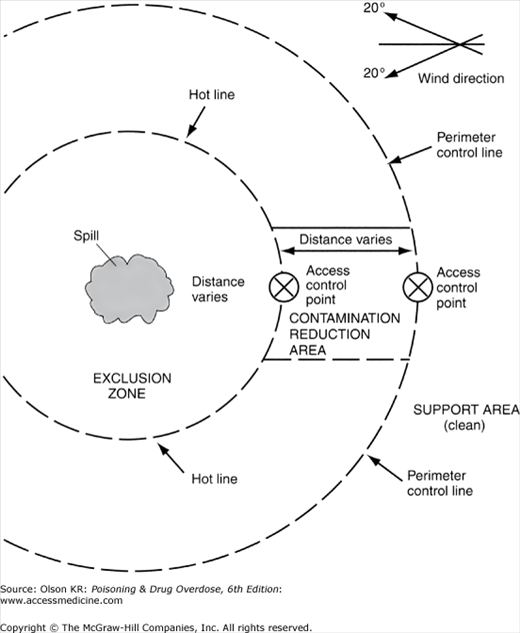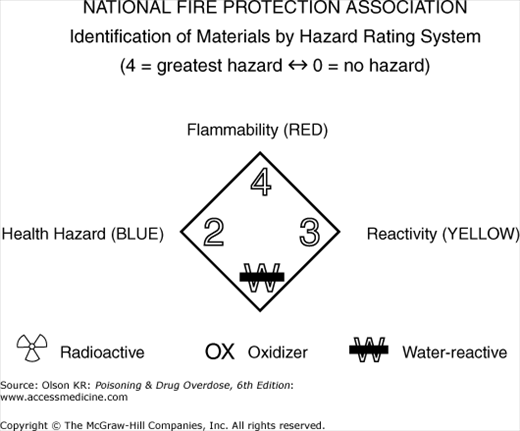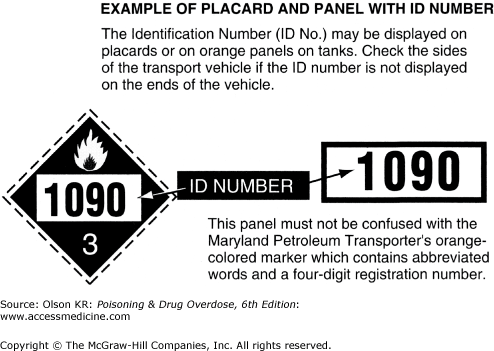Emergency Medical Response to Hazardous Materials Incidents
With the constant threat of accidental releases of hazardous materials and the potential use of chemical weapons by terrorists, local emergency response providers must be prepared to handle victims who may be contaminated with chemical substances. Many local jurisdictions have developed hazardous materials (HazMat) teams; these usually are composed of fire, environmental, and paramedical personnel trained to identify hazardous situations quickly and take the lead in organizing a response. Health care providers such as ambulance personnel, nurses, physicians, and local hospital officials should participate in emergency response planning and drills with their local HazMat team before a chemical disaster occurs.
General considerations. The most important principles of successful medical management of a hazardous materials incident are the following:
Use extreme caution when dealing with unknown or unstable conditions.
Rapidly assess the potential hazard severity of the substances involved.
Determine the potential for secondary contamination of downstream personnel and facilities.
Perform any needed decontamination at the scene before victim transport, if possible.
Organization. Chemical accidents are managed under the incident command system. The incident commander or scene manager is usually the senior representative of the agency that has primary traffic investigative authority, but authority may be delegated to a senior fire or health official. The first priorities of the incident commander are to secure the area, establish a command post, create hazard zones, and provide for the decontamination and immediate prehospital care of any victims. However, hospitals must be prepared to manage victims who leave the scene before teams arrive and may arrive at the emergency department unannounced, possibly contaminated, and needing medical attention.
Hazard zones (Figure IV–1) are determined by the nature of the spilled substance and the wind and geographic conditions. In general, the command post and support area are located upwind and uphill from the spill, with sufficient distance to allow rapid escape if conditions change.
The exclusion zone (also known as the “hot” or “red” zone) is the area immediately adjacent to the chemical incident. This area may be extremely hazardous to persons without appropriate protective equipment. Only properly trained and equipped personnel should enter this zone, and they may require vigorous decontamination when leaving the area.
The contamination reduction zone (also known as the “warm” or “yellow” zone) is where victims and rescuers are decontaminated before undergoing further medical assessment and prehospital care. Because of the limitations posed by protective equipment, patients in the exclusion zone and contamination reduction zone generally receive only rudimentary first aid until they are decontaminated.
The support zone (also known as the “cold” or “green” zone) is where the incident commander, support teams, media, medical treatment areas, and ambulances are situated. It is usually upwind, uphill, and a safe distance from the incident.
Medical officer. A member of the HazMat team should already have been designated to be in charge of health and safety. This person is responsible, with help from the technical reference specialist, for determining the nature of the chemicals, the likely severity of their health effects, the need for specialized personal protective gear, the type and degree of decontamination required, and the supervision of triage and prehospital care. In addition, the medical officer, with the site safety officer, supervises the safety of response workers at the emergency site and monitors entry to and exit from the spill site. This person may also be in contact with receiving hospitals regarding the medical care and needs of the victims.
Assessment of hazard potential. Be prepared to recognize dangerous situations and respond appropriately. The potential for toxic or other types of injury depends on the chemicals involved, their toxicity, their chemical and physical properties, the conditions of exposure, and the circumstances surrounding their release. Be aware that the reactivity, flammability, explosiveness, or corrosiveness of a substance may be a source of greater hazard than its systemic toxicity. Do not depend on your senses for safety, even though sensory input (eg, smell) may give clues to the nature of the hazard.
Identify the substances involved. Make inquiries and look for labels, warning placards, and shipping papers.
The National Fire Protection Association (NFPA) has developed a labeling system for describing chemical hazards that is widely used (Figure IV–2).
The US Department of Transportation (DOT) has developed a system of warning placards for vehicles carrying hazardous materials. The DOT placards usually bear a four-digit substance identification code and a single-digit hazard classification code (Figure IV–3). Identification of the substance from the four-digit code can be provided by the regional poison control center, CHEMTREC, or the DOT manual (see Item B below).
Shipping papers, which may include material safety data sheets (MSDSs), usually are carried by a driver or pilot or may be found in the truck cab or pilot’s compartment.
Obtain toxicity information. Determine the acute health effects and obtain advice on general hazards, decontamination procedures, and the medical management of victims. Resources include the following:
Regional poison control centers

Stay updated, free articles. Join our Telegram channel

Full access? Get Clinical Tree







